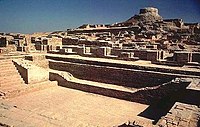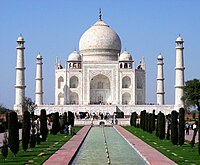Informatics Educational Institutions & Programs
Contents













Architecture of India is rooted in its history.[2] Indian architecture progressed with time and assimilated the many influences that came as a result of India's global discourse with other regions of the world throughout its millennia old past.[2] The architectural methods practiced in India are a result of examination and implementation of its established building traditions and outside cultural interactions.[2]
Though old, this Eastern tradition has also incorporated modern values as India became a modern nation state.[2] The economic reforms of 1991 further bolstered the urban architecture of India as the country became more integrated with the world's economy.[2] Traditional Vastu Shastra remains influential in India's architecture during the contemporary era.[2]
Mehrgarh culture—Indus Valley Civilization (7000 BCE—1500 CE)
Archaeological evidence from Mehrgarh (7000 BCE) shows construction of mud brick houses and granaries.[3] Irrigation was developed in the Indus Valley Civilization around 4500 BCE.[4] The size and prosperity of the Indus civilization grew as a result of this innovation, which eventually lead to more planned settlements which further made use of drainage and sewers.[4]
By 2800 BCE, private bathrooms, located on the ground floor, were found in nearly all the houses of the Indus Valley Civilization.[5] The pottery pipes in walls allowed drainage of water and there was, in some case, provision of a crib for sitting.[5] The Indus Valley Civilization had some of the most advanced private lavatories in the world.[5] "Western-style" toilets were made from bricks using toilet seats made of wood on top.[5] The waste was then transmitted to drainage systems.[5] Sophisticated irrigation and storage systems were developed by the Indus Valley Civilization, including the artificial reservoirs at Girnar in 3000 BCE and an early canal irrigation system from circa 2600 BCE.[6]
Large-scale sanitary sewer systems were in place in the Indus Valley by 2700 BCE.[5] The drains were 7-10 feet wide and 2 feet (0.61 m) below ground level.[5] The sewage was then led into cesspools, built at the intersection of two drains, which had stairs leading to them for periodic cleaning.[5] Plumbing using earthenware plumbing pipes with broad flanges for easy joining with asphalt to stop leaks was in place by 2700 BCE.[5]
Pramod Chandra (2008) details the Indus Valley architecture from 2500–1800 BCE:[7]
From excavated remains, it is clear that the Indus Valley civilization possessed a flourishing urban architecture. The major cities associated with the civilization, notably Mohenjo-daro, Harappā, and Kalibangan, were laid out on a grid pattern and had provisions for an advanced drainage system. The residential buildings, which were serviceable enough, were mainly brick and consisted of an open patio flanked by rooms. For monumental architecture, the evidence is slight, the most important being a “sacred” tank (thought to be for ritual ablution) and associated structures. Corbel vaulting (arches supported by brackets projecting from the wall) was known, and, to a limited extent, timber was used together with brick; whatever architectural ornamentation existed must have been of brick or plaster.
Vedic period—Post Maha Janapadas period (1500 BCE—200 CE)
The Buddhist stupa, a dome shaped monument, was used in India as a commemorative monument associated with storing sacred relics.[8] The stupa architecture was adopted in Southeast and East Asia, where it became prominent as a Buddhist monument used for enshrining sacred relics.[8] Upon its discovery, this architectural became known as pagoda to the people from the western world.[8] Fortified cities with stūpas, viharas, and temples were constructed during the Maurya empire (c. 321–185 BCE).[7] Wooden architecture was popular and rock cut architecture became solidified.[7] Guard rails—consisting of posts, crossbars, and a coping—became a feature of safety surrounding a stupa.[7] Temples—build on elliptical, circular, quadrilateral, or apsidal plans—were constructed using brick and timber.[7] The Indian gateway archs, the torana, reached East Asia with the spread of Buddhism.[9] Some scholars hold that torii derives from the torana gates at the Buddhist historic site of Sanchi (3rd century BCE - 11 century CE).[10]
Rock-cut stepwells in India date from 200-400 CE.[11] Subsequently, the wells at Dhank (550-625 CE) and construction of stepped ponds at Bhinmal (850-950 CE) takes place.[11] The city of Mohenjo-daro has wells which may be the predecessors of the step well; as many as 700 wells, constructed by 3rd millennium BCE, have been discovered in just one section of the city, leading scholars to believe that 'cylindrical brick lined wells' were invented by the people of the Indus Valley Civilization.[12] Cave temples became prominent throughout western India, incorporating various features and material to give rise to cave architecture in places such as Ajatna and Ellora.[7]
Walled and moated cities with large gates and multi-storied buildings which consistently used arched windows and doors are important features of the architecture during this period.[7] The Indian emperor Ashoka (rule: 273 BCE to 232 BCE) himself established a chain of hospitals throughout the Mauryan empire by 230 BCE.[13] One of the edicts of Ashoka (272—231 BCE) reads: "Everywhere King Piyadasi (Asoka) erected two kinds of hospitals, hospitals for people and hospitals for animals. Where there were no healing herbs for people and animals, he ordered that they be bought and planted."[14] Buddhist architecture blended with Roman architecture and Hellenestic architecture to give rise to unique blends—such as the Greco-Buddhist school.[15]
Early Common Era—High Middle Ages (200 CE—1200 CE)
Universities—housing thousands of teachers and students—flourished at Nalanda and Valabhi between the 4th-8th centuries.[16] South Indian temple architecture—visible as a distinct tradition during the 7th century CE—is described below:[17]
The South Indian temple consists essentially of a square-chambered sanctuary topped by a superstructure, tower, or spire and an attached pillared porch or hall (maṇḍapa, or maṇṭapam), enclosed by a peristyle of cells within a rectangular court. The external walls of the temple are segmented by pilasters and carry niches housing sculpture. The superstructure or tower above the sanctuary is of the kūṭina type and consists of an arrangement of gradually receding stories in a pyramidal shape. Each story is delineated by a parapet of miniature shrines, square at the corners and rectangular with barrel-vault roofs at the centre. The tower is topped by a dome-shaped cupola and a crowning pot and finial.
North Indian temples showed increased elevation of the wall and elaborate spire by the 10th century.[18] Richly decorated temples—including the complex at Khajuraho—were constructed in Central India.[18] Indian traders bought Indian architecture to South east Asia through various trade routes.[15]
Late Middle Ages—Early Modern Era (1200 CE—1757 CE)
Pramod Chandra (2008) holds that the Indo-Islamic architecture of Gujarat was unique and indigenous as it 'reinterprets foreign influences with great resourcefulness and confidence, producing works notable for their integrity and unity'.[7] Foreign influences assimilated into native traditions led to the rise of Mughal architecture.[7] Hindu kingdoms adopted aspects of Indo-Islamic architecture to construct palaces among other structures.[7] The first prefabricated homes and movable structures were invented in 16th century Mughal India by Akbar the Great.[19] These structures were reported by Arif Qandahari in 1579.[19]
Mughal tombs of sandstone and marble show Persian influence.[20] The Red Fort at Agra (1565–74) and the walled city of Fatehpur Sikri (1569–74) are among the architectural achievements of this time—as is the Taj Mahal, built as a tomb for Queen Mumtaz Mahal by Shah Jahan (1628–58).[20] Employing the double dome, the recessed archway, white marble and parks while stressing on symmetry and detail was visible during the reign of Shah Jahan.[21] Quranic verses were described on the walls of the buildings.[2] However, the depiction of any living being—and essential part of the pre-Islamic tradition of India—was forbidden under Islam.[2]
Some scholars hold that cultural contact with Europe under Manuel I of Portugal (reign: October 25, 1495—December 13, 1521) resulted in exchange of architectural influences.[22] Little literary evidence exists to confirm the Indian influence but some scholars have nonetheless suggested a possible relation based on proximity of architectural styles.[22]
Colonial British Era (1757 CE—1947 CE)
European colonialism bought with it a wide array of influences to further shape Indian architecture.[2] Imperial power was stressed by using grand buildings.[2] Local craftsmen incorporated new skills and added them to their trade.[2] Colonial architecture became assimilated into India's diverse traditions.[2] Other innovations made during the European Industrial Revolution came with the British Raj to India.[2]
The European involvement in India through the 1920s and the 1930s bought architect Le Corbusier and the Art Deco movement to India.[23] Fusion has been a consistent feature of modern Indian architecture—for example Indian elements of chhajja (wide roof overhangs), jaali (circular stone apertures) and chhatri (free-standing pavilions) were intermixed with European architecture during the construction of the Rastrapati bhavan.[23] This neoclassical project—which also contained a stupa like dome—was overseen by Sir Edwin Landseer Lutyens and the Indian Institute of Architects (est. 1920).[23]
Republic of India (1947 CE—present)
In recent times there has been a movement of population from rural areas to urban centres of industry, leading to price rise in property in various cities of India.[24] Urban housing in India balances space constrictions and is aimed to serve the working class.[25] Indian government has accepted World Trade Organisation’s General Agreement on Trade in Services (GATS), enabling foreign architects to practice in India, and thereby adding to the plurality of Indian building traditions.[24] Growing awareness of ecology has influenced architecture in India during modern times.[26]
Indian buildings reflect India's culture and myths.[24] Jawahar Kala Kendra at Jaipur—for example— represents the layout of a mandala.[24] Raj Jadhav (2007) notes the position of traditional Vastu Shastra in modern Indian architecture:[24]
The ancient Indian architectural text of Vastu Shastra is widely used in modern Indian architecture for planning houses, residential complexes, office, commercial, industrial and other building types. The principles of Vastu Shastra regulate planning and design specifics from town planning to the furniture layout of a room. The stipulations are said to be governed by ancient empirical knowledge of the human body and its relation to the earth and the cosmos. Following these stipulations, it is said, ensures overall human well-being. Hence, a client with a belief in Vastu Shastra will choose a plot of land and locate the functions and elements of a building using the guidelines of this text. Architects and clients consult specialists in Vastu Shastra and then agree upon a design. The belief in this ancient body of knowledge is experiencing a rapid revival.
Security is a main concern in government buildings.[27] The architecture of these buildings lays emphasis on security precautions.[27] One method of achieving that may be designing separate entrances for separate user groups.[27] The VIP entrances and exits can have required security arrangements for ensuring safety.[27]
Concentricity has been employed in Indian architecture since millenia.[28] The plan of early buildings aligned them to a spiritual motif corresponding to cosmological imagination.[28] The concentric feature of Indian architecture is common to buildings of various regions and cultures within India—notable examples being various Hindu temples, the Taj Mahal, and buildings constructed according to Rajasthani architecture.[28] This plan is divided into various parts by the designer who uses concentric placing of these parts in his construction.[28] Modern Indian architects continue to use and incorporate this feature in buildings—for example in the Indian Parliament Library or the Vidhan Sabha (Bhopal).[28][29]
A significant feature of India's architecture is the courtyard.[30] Klaus-Peter Gast (2007) elaborates on the significance of courtyards in India:[30]
The courtyards also take up an old Indian architectural motif whereby the courtyard provides light and air for the rooms directly in this hot climate, and people are able to spend time outside or inside according to the time of day. The courtyard is also the classical symbol of something shared, a place where people meet, spend time with each other and live together. This aspect is emphasised in the courtyard for the general public, which is placed immediately inside the entrance and constructed in the form of a Kund, a large area of stone steps. Here people spend their waiting time together almost as if in a state of communal meditation. A waiting area that would be completely inconceivable in Western culture functions as a “think tank” here, with the ambience of waiting stimulating communal reflection.
Climate responsive architecture has long been a feature of India's architecture but has been losing its significance as of late.[31] Indian architecture reflects its various socio-cultural sensibilities which vary from region to region.[31] Certain areas are traditionally held to be belonging to women.[31] Villages in India have features such as courtyards, loggias, terraces and balconies.[25] Calico, chintz, and palampore—of Indian origin—highlight the assimilation of Indian textiles in global interior design.[32]
See also
Notes
- ^ Singh, Vijay P. & Yadava, R. N. (2003). Water Resources System Operation: Proceedings of the International Conference on Water and Environment. Allied Publishers. 508. ISBN 817764548X.
- ^ a b c d e f g h i j k l m Raj Jadhav, pages 7-13 in Modern Traditions: Contemporary Architecture in India
- ^ Possehl, Gregory L. (1996)
- ^ a b Rodda & Ubertini, page 279
- ^ a b c d e f g h i Teresi, pages 351-352
- ^ Rodda & Ubertini, page 161
- ^ a b c d e f g h i j Chandra 2008
- ^ a b c Encyclopedia Britannica (2008). Pagoda.
- ^ Encyclopedia Britannica (2008). torii
- ^ Japanese Architecture and Art Net Users System (2001). torii.
- ^ a b Livingston & Beach, page xxiii
- ^ Livingstone & Beach, page 19
- ^ Piercey & Scarborough (2008)
- ^ Finger, Stanley (2001). Origins of Neuroscience: A History of Explorations Into Brain Function. US: Oxford University Press. 12. ISBN 0195146948.
- ^ a b Moffett, M.; Fazio, M.; and Lawrence Wodehouse (2003). A World History of Architecture. McGraw-Hill Professional. 75. ISBN 0071417516.
- ^ Mukerji, S.N. (2008). education, history of. Encyclopedia Britannica.
- ^ South Indian temple architecture. Encyclopedia Britannica 2008.
- ^ a b North Indian temple architecture. Encyclopedia Britannica 2008.
- ^ a b Irfan Habib (1992), "Akbar and Technology", Social Scientist 20 (9-10): 3-15 [3-4]
- ^ a b Mughal architecture. Encyclopedia Britannica (2008)
- ^ Shāh Jahān period architecture. Encyclopedia Britannica 2008.
- ^ a b Lach, 57-62
- ^ a b c Gast, page 19
- ^ a b c d e Raj Jadhav, page 11 in Modern Traditions: Contemporary Architecture in India
- ^ a b Gast, page 77
- ^ Gast, page 119
- ^ a b c d Gast, page 27-29
- ^ a b c d e Gast, page 45
- ^ Gast, page 27
- ^ a b Gast, page 29
- ^ a b c Raj Jadhav, page 13 in Modern Traditions: Contemporary Architecture in India
- ^ Savage 2008
References
- Chandra, Pramod (2008). "Indian architecture" in South Asian arts. Encyclopedia Britannica.
- Gast, Klaus-Peter (2007). Modern Traditions: Contemporary Architecture in India. Birkhäuser. Germany: ISBN 978-3-7643-7754-0.
- Lach, Donald F. (1993). Asia in the Making of Europe (vol. 2). University of Chicago Press. ISBN 0226467309.
- Livingston, Morna & Beach, Milo (2002). Steps to Water: The Ancient Stepwells of India. Princeton Architectural Press. ISBN 1568983247.
- Possehl, Gregory L. (1996). "Mehrgarh" in Oxford Companion to Archaeology, edited by Brian Fagan. Oxford University Press.
- Savage, George (2008). interior design. Encyclopedia Britannica.
- Teresi, Dick (2002). Lost Discoveries: The Ancient Roots of Modern Science—from the Babylonians to the Maya. Simon & Schuster. ISBN 0684837188.
- Rodda & Ubertini (2004). The Basis of Civilization—-water Science?. International Association of Hydrological Science. ISBN 1901502570.
- Piercey, W. Douglas & Scarborough, Harold (2008). hospital. Encyclopedia Britannica.
External links
Further reading
- Allchin, F.R. & Erdosy, G. (1995). The Archaeology of Early Historic South Asia: The Emergence of Cities and States. Cambridge University Press. ISBN 0521376955.
- Allen, M.P. (1991). Ornament in Indian Architecture. University of Delaware Press. ISBN 0874133998
















